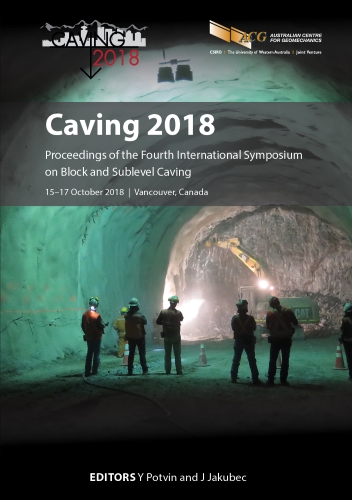Three-dimensional simulation of cave initiation, propagation and surface subsidence using a coupled finite difference–cellular automata solution

|
Authors: Hebert, Y; Sharrock, G |
DOI https://doi.org/10.36487/ACG_rep/1815_09_Hebert
Cite As:
Hebert, Y & Sharrock, G 2018, 'Three-dimensional simulation of cave initiation, propagation and surface subsidence using a coupled finite difference–cellular automata solution', in Y Potvin & J Jakubec (eds), Caving 2018: Proceedings of the Fourth International Symposium on Block and Sublevel Caving, Australian Centre for Geomechanics, Perth, pp. 151-166, https://doi.org/10.36487/ACG_rep/1815_09_Hebert
Abstract:
This paper outlines a new methodology for modelling caveability and subsidence using bi-directional coupling between the continuum code FLAC3D and the cellular automata code CAVESIM. FLAC3D, using the CaveHoek constitutive model, simulates the progressive failure and disintegration of the rock mass from an intact/jointed to a caved material. CAVESIM simulates gravity flow, in particular the collapse, bulking and movement of caved rock. The coupled method captures many important aspects of caveability affecting cave design such as hang-up formation, material recovery, timing of surface breakthrough or interaction with other lifts, crater development, and surface subsidence. The key to improved modelling of many of these aspects is the ability to accurately capture the impact of draw and gravity flow on cave propagation and subsidence.
Keywords: numerical modelling, caveability, subsidence, gravity flow
References:
Baxter, GW & Behringer, RP 1990, ‘Cellular automata models of granular flow’, Physical Review A, vol. 42, no. 2, pp. 1017–1020.
Bergmark, J 1975, The Calculation of Drift Spacing and Ring Burden for Sublevel Caving, report no. RU 75-16, Luossavaara-Kiirunavaara Aktiebolag, Kiruna, in Swedish.
Borowsk, EJ & Borwein, JM 1991, The Harper Collins Dictionary of Mathematics, Harper Collins, New York.
Brown, ET & Trollope, DH 1970, ‘Strength of a model of jointed rock’, Journal of Soil Mechanics and Foundations Division, vol. 96, pp. 685–704.
Chitombo, G & Pierce, ME 2012, A Practical Guide on the Use of the MMT Tools and Methodologies - Block Panel and Sublevel Caving, report to Mass Mining Technology project.
Duplancic, P & Brady, BH 1999, ‘Characterization of caving mechanisms by analysis of seismicity and rock stress’, Proceedings of the 9th International Congress on Rock Mechanics, vol. 2, A.A. Balkema, Rotterdam, pp. 1049–1053.
Fox, GC, Williams, RD & Messima, PC 1994, Parallel Computing Works, Morgan Kaufmann, San Francisco.
Heden, H 1976, ‘Physical models for describing gravity flow’, in H Heden (ed.), Proceedings of the Seminar on Sublevel Caving in Kiruna, Luossavaara-Kiirunavaara Aktiebolag, Kiruna, pp. 1–9, in Swedish.
Hoek, E, Carranza-Torres, C & Corkum, B 2002, ‘Hoek-Brown failure criterion - 2002 edition’, in R Hammah (ed.), Proceedings of the 5th North American Rock Mechanics Symposium and the 17th Tunnelling Association of Canada Conference, University of Toronto, Toronto, pp. 267–273.
Hoek, E & Diederichs, MS 2006, ‘Empirical estimation of rock mass modulus’, International Journal of Rock Mechanics and Mining Sciences, vol. 43, pp. 203–215.
Laubscher, DH 1990, ‘A geomechanical classification system for the rating of rock mass in mine design’, Journal of the South African Institute of Mining and Metallurgy, vol. 90, no. 10, pp. 257–273.
Laubscher, DH 1994, ‘Cave mining – the state of the art’, Journal of the South African Institute of Mining and Metallurgy, vol. 94, no. 10, pp. 279–293.
Lorig, L 2000, The Role of Numerical Modelling in Assessing Caveabilty, Itasca Consulting Group Inc., Minneapolis, report to the International Caving Study, ICG00-099-3-16.
Lorig, L & Pierce, M 2000, Methodology and Guidelines for Numerical Modelling of Undercut and Extraction Level Behaviour in Caving Mines, Itasca Consulting Group Inc., Minneapolis, report to the International Caving Study.
Lupo, JF 1998, ‘Large-scale surface disturbances resulting from underground mass mining’, International Journal of Rock Mechanics and Mining Sciences, vol. 35, no. 4–5, paper no. 25.
Nedderman, RM 1992, Statics and Kinematics of Granular Materials, Cambridge University Press, Cambridge.
Nilsson, L 1988, A Theoretical Model of Gravity Flow in Sublevel Caving, report no. 88-740, Luossavaara-Kiirunavaara Aktiebolag, Kiruna, in Swedish.
Pappas, D & Mark, C 1993, Behaviour of Simulated Longwall Gob Material, Report of Investigations 9458, United States Department of the Interior, Bureau of Mines, Washington DC.
Pierce, M 2010, CaveHoek Constitutive Model: Theory and Implementation, Itasca technical memorandum.
Pierce, M 2013, ‘Numerical modeling of rock mass weakening, bulking and softening associated with cave mining’, ARMA eNewsletter, Spring 2013, no. 9.
Sharrock, GB, Beck, DA, Capes, G & Brunton, I 2012, ‘Applying coupled Newtonian cellular automata-discontinuum finite element models to simulate propagation of Ridgeway Deeps Block Cave’, Proceedings of MassMin 2012, Canadian Institute of Mining, Metallurgy and Petroleum, Westmount.
Van As, A, Davison, J & Moss, A 2003, Subsidence Definitions for Block Caving Mines, Rio Tinto technical report, Rio Tinto Technical Services.
von Neumann, J 1966, Theory of Self-reproducing Automata, University of Illinois Press, Urbana.
© Copyright 2026, Australian Centre for Geomechanics (ACG), The University of Western Australia. All rights reserved.
View copyright/legal information
Please direct any queries or error reports to repository-acg@uwa.edu.au
View copyright/legal information
Please direct any queries or error reports to repository-acg@uwa.edu.au
